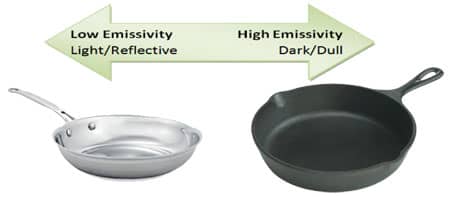Emissivity
Not all surfaces are created equal. Depending on what you’re pointing your infrared gun at you’re likely to get variations in emitted infrared energy. This variation is called emissivity.
What is Emissivity?
Emissivity is a measure of a material’s ability to emit infrared energy. It is measured on a scale from just about 0.00 to just below 1.00.
 Generally, the closer a material’s emissivity rating is to 1.00, the more that material tends to
absorb reflected or ambient infrared energy and emit only its own infrared radiation. Most organic materials,
including the by-products of plants and animals, have an emissivity rating of 0.95. These are ideal surfaces for
accurate temperature readings.
Generally, the closer a material’s emissivity rating is to 1.00, the more that material tends to
absorb reflected or ambient infrared energy and emit only its own infrared radiation. Most organic materials,
including the by-products of plants and animals, have an emissivity rating of 0.95. These are ideal surfaces for
accurate temperature readings.
Substances with very low emissivity ratings, like highly polished metals, tend to be very reflective of ambient infrared energy and less effective at emitting their own electromagnetic waves. If you were to point an infrared thermometer with fixed emissivity at the side of a stainless steel pot filled with boiling water, for example, you might get a reading closer to 100°F (38°C) than 212°F (100°C). That’s because the shiny metal is better at reflecting the ambient radiation of the room than it is at emitting its own infrared radiation.
What is fixed emissivity?
Fixed emissivity is a setting in some infrared thermometers (usually of 0.95 or 0.97) that attempts to simplify their operation while leaving them suitable for most material surfaces, including almost all foods. Other infrared thermometers come with adjustable emissivity settings, so you can more accurately prepare your infrared thermometers for the type of surface being measured, particularly when measuring non-organic surfaces.
Infrared Thermometers With Fixed Emissivity:
IR Food Safety
Pocket Infrared
Infrared Thermometers With Adjustable Emissivity:
Cold Zone Infrared
IR-Gun-S
Thermapen IR
IRK 2 +Type K TC Input
IRT 2 +Type T TC Input
RayTemp 2 Plus
Industrial Infrared Thermometer (IR-IND)
IR-Pro
IR-Pro USB Professional
IR-Pro-75 Professional
IR-Pro-100 Professional
